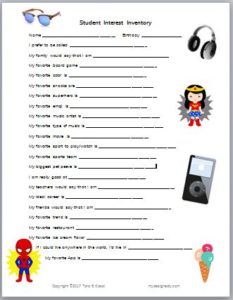Peek into classrooms during the first week of school and you will find students completing a student interest inventory. Teachers collect this information, but don’t always know how to use it effectively. Combine the information you’ve collected with this research-based strategy that will positively impact even your most challenging student.
“Two-By-Ten”
“Two-By-Ten” is a strategy that improves the teacher-student relationship. According to research, teachers who have used this strategy have seen an 85% improvement in the student’s behavior, which in turn improves all of the other students’ behavior as well.
Here’s how the strategy works. Spend 2 minutes a day for 10 days straight, talking with your most challenging student about anything he or she wants to discuss. The focus of the conversation needs to be about things outside of school—hobbies, interests, likes, etc.
At first, it may feel awkward trying to think of things to talk about with a student for 2 minutes a day every day for 10 days, especially when discussions about academics, grades, and discipline are off-limits!
Student Interest Inventory
Here’s where the student interest inventory helps. Look back at the student’s interest inventory form and identify hobbies, interests, likes, dislikes, etc. to give you a starting point.
Use this information to engage the student in a conversation, allowing the student to take the lead. By asking the right questions and listening carefully to the responses, you will learn a lot about your most challenging student. You may even begin to see this student with a different set of eyes because your own perception has changed.
A word of caution—students know when you are being real. If your goal is to get to know the student, your authenticity will come through and the student will trust the connection you are trying to make. If your goal is to get them to do something for you (behave better), your attempt at manipulation will only further push the student away. Improved attitude and behavior is a by-product of a stronger teacher-student relationship.
This strategy can be hard to implement because the student that you are going to “get to know” is a student who has been acting up in class. Giving one-on-one attention to your most challenging student may seem like you are positively reinforcing negative behavior in the classroom, but you’re not. According to Smith and Lambert,
…The students who seemingly deserve the most punitive consequences we can muster are actually the ones who most need a positive personal connection with their teacher. When they act out, they are letting us know that they are seeking a positive connection with an adult authority figure and that they need that connection first, before they can focus on learning content.
Be Intentional
Teachers have to be intentional about creating opportunities to implement this strategy, because it will not happen simply by waiting for an opportunity to present itself. The school day is already full.
Implemented effectively, at the end of 10 days you will know the student better and you will have strengthened the teacher-student relationship. Teachers find that they naturally continue having conversations with the student beyond the 10 days because of the benefit to the teacher-student relationship. Improvement in the student’s attitude and/or behavior will also be evident because the student is on the receiving end of the positive attention they are craving.
Intentionally design a student interest inventory, or download the one below, to collect useful information about your students’ interests. Later, use the information to start conversations with your students when using the “Two-By-Ten” strategy. Give it a try and let me know how it works for you.
What are some other ways that you use a Student Interest Inventory in your classroom? Leave a comment below.

